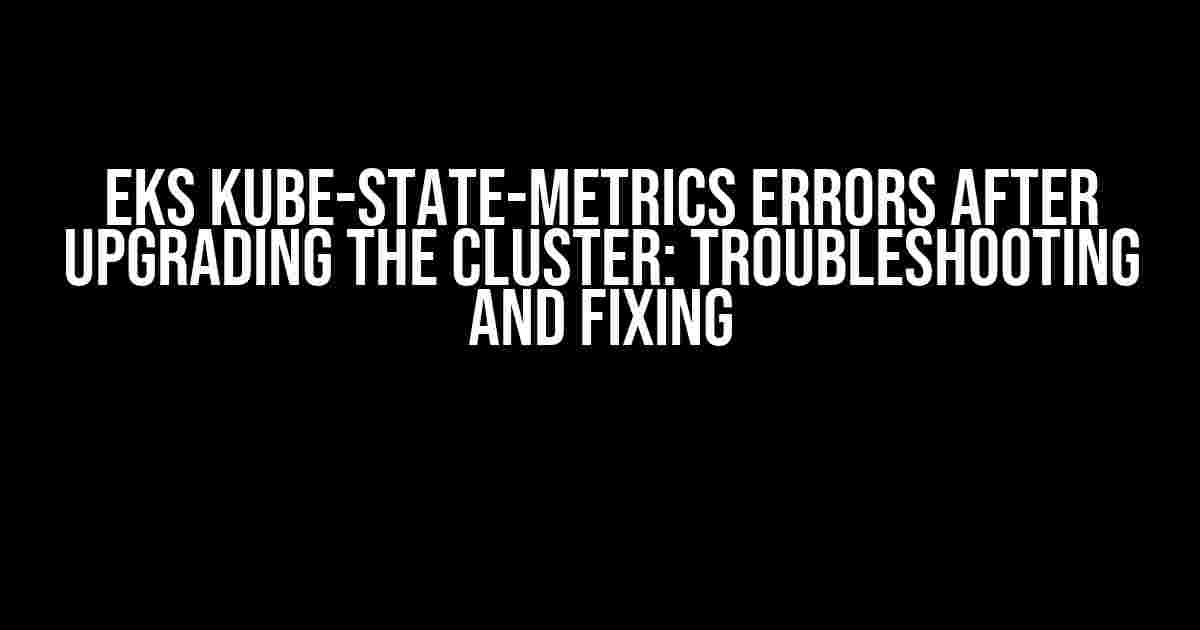If you’re reading this article, chances are you’ve encountered the frustrating issue of kube-state-metrics errors after upgrading your EKS cluster. Don’t worry, you’re not alone! Many developers and DevOps engineers have faced this problem, and we’re here to guide you through the troubleshooting and fixing process.
What are Kube-State-Metrics?
Kube-state-metrics is a Kubernetes add-on that provides a simple way to generate metrics from your cluster’s state. It collects data from various sources, such as deployments, pods, and nodes, and exposes them as Prometheus metrics. This allows you to monitor and analyze your cluster’s performance and health.
The Error Scenario
Error from server (NotFound): deployments.metrics.k8s.io "kube-state-metrics" not found
You’ve upgraded your EKS cluster, and suddenly, your kube-state-metrics deployment starts throwing errors. The error message indicates that the deployment can’t be found, even though you’re certain it existed before the upgrade. This is where the troubleshooting journey begins!
Troubleshooting Steps
Step 1: Verify the Deployment YAML
Let’s start by checking the deployment YAML file. Make sure it’s correctly formatted and contains the necessary information.
apiVersion: apps/v1
kind: Deployment
metadata:
name: kube-state-metrics
spec:
selector:
matchLabels:
app: kube-state-metrics
template:
metadata:
labels:
app: kube-state-metrics
spec:
containers:
- name: kube-state-metrics
image: quay.io/kube-state-metrics/kube-state-metrics:latest
args:
- --kubeconfig=/kubeconfig
- --metric-set=none
- --metric-set=kubernetes
- --metric-set=node
- --metric-set=pod
- --metric-set=service
volumeMounts:
- name: kubeconfig
mountPath: /kubeconfig
volumes:
- name: kubeconfig
secret:
secretName: kube-state-metrics-kubeconfig
In this example, we’re using the latest image and specifying the necessary arguments for kube-state-metrics.
Step 2: Check the Deployment Status
Use the following command to check the deployment status:
kubectl get deployments -n kube-system
If the deployment is not listed, proceed to the next step.
Step 3: Create the Deployment
Create the deployment using the YAML file:
kubectl apply -f deployment.yaml
Verify that the deployment has been created successfully:
kubectl get deployments -n kube-system
Step 4: Check the Pods
Verify that the pods are running:
kubectl get pods -n kube-system
If the pods are not running, check the pod logs for errors:
kubectl logs -f-n kube-system
Common Issues and Fixes
Issue 1: Missing or Corrupted Kubeconfig
If the kubeconfig is missing or corrupted, kube-state-metrics won’t function properly. Ensure that the kubeconfig is correctly generated and stored as a secret:
apiVersion: v1 kind: Secret metadata: name: kube-state-metrics-kubeconfig namespace: kube-system type: Opaque data: kubeconfig:
Issue 2: Incompatible Image Version
Make sure the image version is compatible with your EKS cluster version. You can check the compatible versions in the kube-state-metrics releases page.
Issue 3: Insufficient Permissions
Kube-state-metrics requires certain permissions to function correctly. Ensure that the service account has the necessary permissions:
apiVersion: rbac.authorization.k8s.io/v1 kind: ClusterRole metadata: name: kube-state-metrics rules: - apiGroups: - "" resources: - nodes - pods - services verbs: - get - list - watch
Conclusion
By following these troubleshooting steps and fixes, you should be able to resolve the kube-state-metrics errors after upgrading your EKS cluster. Remember to verify the deployment YAML, check the deployment status, and troubleshoot any pod issues. If you encounter any other problems, feel free to explore the official Kubernetes documentation and seek help from the community.
Additional Resources
| Common Errors | Solutions |
|---|---|
| Error from server (NotFound): deployments.metrics.k8s.io “kube-state-metrics” not found | Verify the deployment YAML, check the deployment status, and troubleshoot pod issues |
| Kube-state-metrics pod is not running | Check pod logs for errors, ensure correct image version, and verify permissions |
| Kube-state-metrics is not collecting metrics | Verify the kubeconfig, check the deployment YAML, and ensure correct permissions |
By following this guide, you should be able to resolve the kube-state-metrics errors and get your EKS cluster up and running smoothly. Happy troubleshooting!
Frequently Asked Questions
Uh-oh, EKS kube-state-metrics errors after upgrading the cluster? Don’t worry, we’ve got you covered! Here are some frequently asked questions to help you troubleshoot the issue:
Q1: What’s the most common cause of EKS kube-state-metrics errors after upgrading the cluster?
One of the most common causes is due to incompatible versions of kube-state-metrics and the Kubernetes cluster. Make sure to check the compatibility matrix and update kube-state-metrics to a version that’s compatible with your cluster’s Kubernetes version.
Q2: How do I check the kube-state-metrics logs for errors?
You can check the kube-state-metrics logs using the command `kubectl logs -f kube-state-metrics` (in the namespace where kube-state-metrics is running). This will help you identify any error messages that can give you a hint about what’s going on.
Q3: What if I’m using an older version of kube-state-metrics and don’t want to upgrade?
If you’re stuck on an older version of kube-state-metrics, you might need to downgrade your Kubernetes cluster version to a compatible version. However, we strongly recommend against this, as it can lead to security vulnerabilities and other issues. It’s always best to upgrade to the latest version of kube-state-metrics and Kubernetes for the best support and features.
Q4: Can I use a different metrics scraper instead of kube-state-metrics?
Yes, you can use alternative metrics scrapers like Prometheus or Metrics Server. However, keep in mind that these alternatives might require additional configuration and setup. kube-state-metrics is a popular choice because it’s widely adopted and well-maintained, but if you have specific requirements, other options might be suitable.
Q5: Where can I find more resources to troubleshoot EKS kube-state-metrics errors?
For more resources, check out the official kube-state-metrics documentation, AWS EKS documentation, and Kubernetes documentation. You can also search for online forums, like the Kubernetes Slack channel or Reddit’s r/kubernetes, where you can ask for help from the community.

